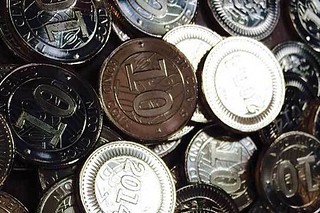
PREV ARTICLE
NEXT ARTICLE
FULL ISSUE
PREV FULL ISSUE
ZIMBABWE CONSIDERS NEW BOND COIN ISSUE
We've been following for some time the currency troubles of Zimbabwe, first with their hyperinflation and more recently with the
"Bond Coins" introduced to alleviate the shortage of small change in commerce. Now changing exchange rates are causing new
troubles. Here's an article passed along by Pabitra Saha. Thanks. -Editor
The economy’s demand for lower denominations is estimated at as much as US$447 million, based on official money supply statistics. Already, Zimbabwe has US$20 million worth of bond coins in circulation. Asked to give the amount of coins sufficient to meet the country’s change needs, an senior official at the central bank said: “It’s not easy to determine the amount of coins we need because the economy has undergone a fundamental structural change over the past 15 years, but under normal circumstances, small denominations would be between 5 and 10% of money in circulation.” Prior to December 2014, Zimbabweans suffered a change crisis that forced many citizens to accept sweets or other items as change. At best, consumers were given tokens that were equivalent to money but only accepted at the issuing outlet. This was a result of lack of coins as the country struggled to import adequate change after adopting a multiple currency regime in 2009. Although the multiple currency system had been dominated by the US dollar, the South African rand coins topped smaller denominations as the US coins are heavy and expensive to import considering too the distance between Zimbabwe and the USA. The Reserve Bank of Zimbabwe is on record saying shipping the US coins from the USA can cost Zimbabwe millions of US dollars which will make the production and importation price above the real value of the coin. Naturally, the economy resolved to use South African rand coins. However, the South African rand coins were not enough to meet demand, with change problems being witnessed more in areas that are further from the Zimbabwe and South African border. To fix the problem, RBZ governor John Mangudya, introduced bond coins in December 2014 that were to be distributed through normal banking channels in denominations of 1c, 5c, 10c and 25c, while the 50c coin was to be later introduced in March 2015. The value of the bond coins is at par with the US cents. The value of bond coins is guaranteed by a fifty million dollar bond facility hence the term bond coins. The bond coins were at first treated with some suspicion, firstly in terms of their ability to store value versus the foreign currencies given the reputation left by the Zimbabwean dollar during the hyperinflation era and as a way in which government was attempting to smuggle back a defunct local currency. A few months later, retailers and informal business preferred the bond coins to South African rands mainly because their value is equal to the US dollar. The new change system has however been disrupted, due to continued devaluation of the South African rand against the US dollar. Pabitra Saha adds: Although the 50 Cent Bond coins were issued in March 2015 but bear the date 2014 since the bond fund for them was created in 2014. If the new bond fund is created in 2015 or 2016, will bond coins have new designs, new KM#s or just the old design with new year? To read the complete article, see:
Wayne Homren, Editor The Numismatic Bibliomania Society is a non-profit organization promoting numismatic literature. See our web site at coinbooks.org. To submit items for publication in The E-Sylum, write to the Editor at this address: whomren@gmail.com To subscribe go to: https://my.binhost.com/lists/listinfo/esylum All Rights Reserved. NBS Home Page Contact the NBS webmaster 
|
